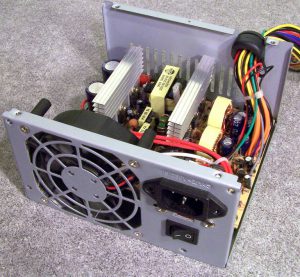The power supply unit is the piece of hardware that’s used to convert the power provided from the outlet into usable power for the many parts inside the computer case.

It converts the alternating current (AC) into a continuous form of power that the computer components need in order to run normally, called direct current (DC). It also regulates overheating by controlling voltage, which may change automatically or manually depending on the power supply.
Unlike some hardware components used with a computer that isn’t necessarily needed, as a printer, the power supply is a crucial piece because, without it, the rest of the internal hardware can’t function.
The power supply unit is often abbreviated as PSU and is also known as a power pack or power converter.
Motherboards, cases, and power supplies all come in different sizes called form factors. All three must be compatible to work properly together.
A PSU is not usually user serviceable. For your safety, it’s usually wise to never open a power supply unit.
CoolMax and Ultra are the most popular PSU makers but most are included with a computer purchase so you only deal with this when replacing one.
Power Supply Unit Description
The power supply unit is mounted just inside the back of the case. If you follow the computer’s power cable, you’ll find that it attaches to the back of the power supply.
It’s the backside that’s usually the only portion of the power supply that most people will ever see.
There’s also a fan opening at the back of the power supply that sends air out the back of the computer case.
The side of the PSU facing outside the case has a male, three-pronged port that a power cable, connected to a power source, plugs into.
There is also often a power switch and a power supply voltage switch.
Large bundles of colored wires extend from the opposite side of the power supply unit into the computer. Connectors at the opposite ends of the wires connect to various components inside the computer to supply them with power. Some are specifically designed to plug into the motherboard while others have connectors that fit into fans, floppy drives, hard drives, optical drives, and even some high powered video cards.
Power supply units are rated by wattage to show how much power they can provide to the computer. Since each computer part requires a certain amount of power to function properly, it’s important to have a PSU that can provide the right amount. The very handy Cooler Master Supply Calculator tool can help you determine how much you need.
More Information on Power Supply Units
The way I describe power supply units above is for ones that are inside a desktop computer. The other type is an external power supply.
For example, some gaming consoles have a power supply attached to the power cable that must sit between the console and the wall. Others are similar, like the power supply unit built-in to some external hard drives, which are required if the device can’t draw enough power from the computer over USB.
External power supplies are beneficial because it allows the device to be smaller and more attractive. However, like I just described, some of these types of power supply units are attached to the power cable and, since they’re generally pretty large, sometimes make it difficult to position the device against the wall.
Power supply units are often victims of power surges and power spikes because it’s where the device receives electrical power. Therefore, it’s often recommended to plug the device into a UPS or surge protector.